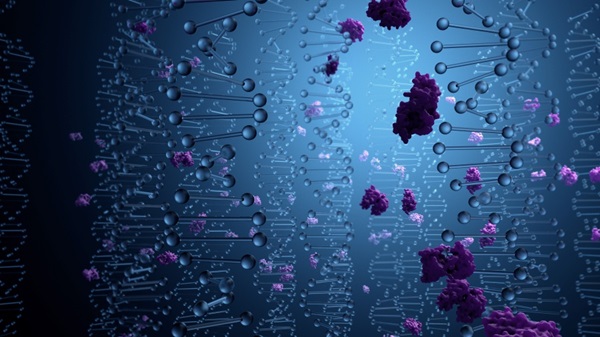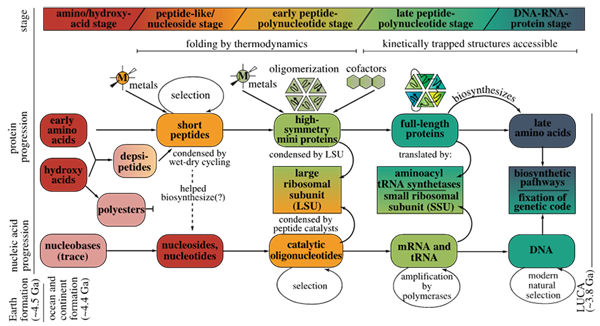How did life start on Earth? This question has been challenging for scientists to answer because it has so many chicken-and-egg dilemmas rolled into one. For example, we know that cells gather energy from their environment, which is driven by complex proteins that require energy to be properly assembled. Meanwhile, proteins are encoded by instructions stored in the nucleotide chain. Hence, the emergence of biopolymers remains a crucial question in the origin of life. This review paper highlights and connects diverse scientific literature to provide a conceptual model of the coevolution of peptides and nucleic acids during and beyond the origin of life.

A theory called the "RNA world hypothesis" has long been around, given its similarity to DNA. It has properties that enable it to store information and acts as a catalyst. Some biochemists have created RNA molecules in the lab that can replicate RNA. These properties seemed to make it a prime contender for the 'first biomolecule.' According to this hypothesis, the ancient Earth was first inhabited with self-replicating RNAs, which later on formed a molecular machine that could build proteins using the information stored in RNA. That machine became the ribosome, which we have in our cells today – roughly 10 million per cell.
Not all scientists have been convinced by the RNA world hypothesis. Writing in Journal of the Royal Society, a team of scientists funded by the Human Frontiers Science Program (HFSP) Young Investigator Grants; Stephen Fried (Johns Hopkins University), Kosuke Fujishima (Earth-Life Science Institute, Tokyo Tech), Klára Hlouchová (Charles University) and co-workers, propose a new framework for the Origin of Life. They emphasise how proteins and nucleic acids (molecules like DNA and RNA) worked together to move the needle from chemistry to biochemistry.

Figure 2 represents our proposed model consisting of five critical stages of polymer evolution. In the earliest stages, we argue that the polypeptides dominate. This is because amino acids should have been abundant on ancient Earth and can easily combine to make polymers. On the other hand, nucleotides, the building blocks to make RNA were much more challenging to make. Peptides could have helped RNA by churning out its building blocks, protecting it, and stringing it together, whilst RNA helped peptides by providing a replicating platform for more efficient reproduction.
The model brings together lines of evidence from diverse research areas, including molecular biology, bioinformatics, geochemistry, biophysics, and astrobiology. "Biochemists like myself don't always talk to experts in evolution or geology," remarked Stephen Fried, one of the authors, "which can make it challenging to tease apart the Origin of Life since it's a question that links together almost every type of science." As a result, the review does not report new data; instead, it threads together evidence from across the scientific literature to create a cohesive narrative.
"This work was stimulated by frequent discussions among us," remarks the HFSP project leader Klara Hlouchova. The authors freely admit that their framework is not without limitations. Rather than being an end to the conversation, it is an invitation for scientists in the field to focus attention in new directions and try experiments that mix RNA and protein to combine their strengths, as opposed to working with just one or the other. Kosuke Fujishima concluded, "We are now entering an exciting period to experimentally validate the model of the reciprocal relationship between RNA and polypeptides".
| Journal | Journal of the Royal Society Interface |
| Tile of the paper | Peptides before and during the nucleotide world: an origins story emphasizing cooperation between proteins and nucleic acids |
| Authors | Stephen D Fried1,2*, Kosuke Fujishima3.4, Mikhail Makarov5, Ivan Cherepashuk5, Klara Hlouchova5,6* |
| Affiliations | 1. Department of Chemistry, Johns Hopkins University, Baltimore, MD 21212, USA. 2. Department of Biophysics, Johns Hopkins University, Baltimore, MD 21212, USA. 3. Earth-Life Science Institute, Tokyo Institute of Technology, Tokyo 1528550, Japan. 4. Graduate School of Media and Governance, Keio University, Fujisawa 2520882, Japan. 5. Department of Cell Biology, Faculty of Science, Charles University, BIOCEV, Prague 12800, Czech Republic. 6. Institute of Organic Chemistry and Biochemistry, Czech Academy of Sciences, Prague 16610, Czech Republic. |
| DOI | 10.1098/rsif.2021.0641 |
| Online published date | 9 Februrary, 2022 |
